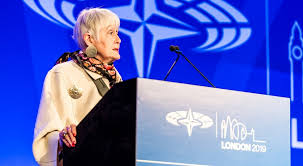EU Defence Data 2011
The European Defence Agency (EDA) published the aggregated defence data for 2011 of the (then) 26 EDA participating Member States.
The European Defence Agency collects defence data on an annual basis. The Ministries of Defence of the Agency’s participating Member States provide the data. EDA acts as the custodian of the data and publishes the aggregated figures.
- In order to measure real growth and ensure a “real” comparison between years, inflation needs to be taken into account. Thus, data from 2006 to 2010 has been inflated to 2011 economic conditions (Source of deflator: European Commission ECFIN – based on weight of EU 27).
- R&T is a subset of R&D which includes only basic research, applied research and technology demonstration, leaving out expenditure for demonstration or development for which a decision to procure has been taken.
Download the web version of the booklet here
Total defence expenditure down by € 1 bln
In 2011, total defence expenditure of EDA 26 pMS amounted to € 192.5 billion – a reduction of € 1 billion or 0.5% compared to 2010 – representing approximately 1.55% of their total GDP and 3.17% of their total government expenditure, both values being the lowest since 2006. In real terms , total defence expenditure has been decreasing since 2006 and between 2010 and 2011 it dropped by over 2%.
Defence investment (procurement and R&D) at its lowest level since 2006
Personnel-related expenditure of € 98.6 billion accounted for 51.1% of total defence spending – virtually unchanged since 2009. The second biggest component – operation and maintenance expenditure – increased by 3.6% and accounted for 23.5% (€ 45.2 bln) of total defence expenditure. However, defence investment, comprising equipment procurement and R&D expenditure, saw a sharp decrease of almost 14% bringing its value down to the lowest level since 2006 (€ 37.0 billion or 19.2% of total expenditure). Both components of investment contributed to the decrease: equipment procurement dropped by 15% (€ 29.2 bln or 15.2% of total expenditure), and R&D expenditure – by 9% (€ 7.8 bln or 4.0% of total expenditure). As for Research and Technology , expenditure increased by 3.5% up to € 2.15 billion reversing a downward trend since 2006.
Increase in collaborative procurement and R&T
In 2011, 27,1% or € 7.9 bln of total defence equipment procurement expenditure was spent on collaborative projects – a slight increase compared to 2010. Of this, 92,7% (€ 7.3 bln) were European collaborations. Although the share of European collaborations in total collaborative equipment procurement decreased by 2% from 2010 to 2011, it nevertheless remained higher than in previous years.
As for R&T, expenditure on collaborative projects and programmes increased by 25.6% breaking a downward trend since 2009, and in 2011 it stood at € 331 mln representing 15.4% of total R&T spend. European collaborative R&T expenditure also increased in absolute terms by over 15% reaching € 283 mln (13.2% of total R&T spend), but as a share of total collaborative R&T expenditure it decreased from 93.1% in 2010 to 85.4% in 2011, its lowest value since 2007.
Numbers of military and civilian personnel continue to drop while expenditure per soldier increases
In 2011, there was a reduction of both civilian and military personnel for the fifth consecutive year. Military personnel (81% of total staff working in defence) decreased by 4.3% to 1.55 million. Civilian personnel decreased by 3.9% to 374 thousand. Whilst personnel numbers reduced, defence expenditure per soldier increased by almost 4% reaching € 124 thousand. Defence investment per soldier, however, decreased by almost 10% and stood at € 24 thousand in 2011.
Reduction in troops deployed, but cost of operations increase
As regards deployed operations outside the EU territory, similarly to the last two years, the average number of troops deployed decreased in 2011 both in absolute terms (from 66 to 54 thousand) and as a share of military personnel (from 4.1% to 3.5%) and is now at its lowest value since 2006. However, costs related to the deployed operations increased substantially (by 12.4% from 2010 to 2011) for the fifth consecutive year, reaching € 11.7 million or 6.1% of total defence expenditure. Operations costs per military deployed have also been steadily increasing, and from 2006 to 2011 it nearly tripled reaching € 218 thousand.
Progress made on three out of four collective benchmarks
In 2007, EDA pMS agreed on a set of collective benchmarks for investment. There is no obligation in terms of timeline or adoption of these benchmarks into national targets, but they can assist pMS in spending more on investment.
In 2011, three out of four indicators made progress towards the agreed benchmarks. R&T expenditure broke a downward trend for the first time since 2006 increasing its share in total defence expenditure slightly from its lowest value in 2010 (1.07%) to 1.12%. It, nevertheless, remains well below the agreed 2% benchmark. At the national level, not a single participating Member States reached the 2% target in 2011.
The share of European collaborative R&T expenditure in total defence R&T spend also increased reaching 13.2% but remains below the 20% benchmark. The biggest progress was observed in European collaborative equipment procurement. As a share of total equipment procurement, it increased by 4 percentage points from 21.2% to 25.2%, the highest value since 2006, although still below the 35% benchmark. There was, however, a retrograde step in defence investment (equipment procurement and R&D). Being above the 20% benchmark between 2007 and 2010, in 2011 it dropped to 19.2% of total expenditure on defence, which is lower than the 2006 level.
other publications
Publications
- 22 JUL Defence Data 2011 Booklet
- 14 JUN Factsheet: e-QUIP
- 11 JUN Factsheet: EATT 2013
Source EDA by rosita scanferla


